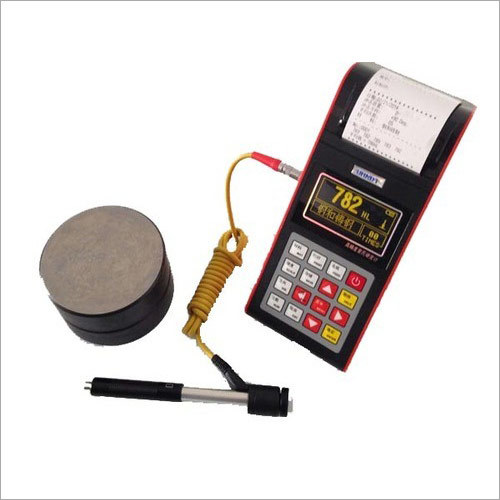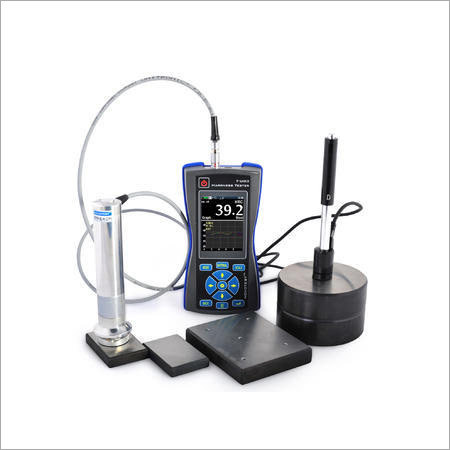Portable Hardness Tester
10000 INR/Unit
Product Details:
- Specimen Size Minimum 10 x 10 x 3 mm
- Automation Grade Semi-Automatic
- Power Supply Electric
- Hardness Leeb, Rockwell, Brinell, Vickers, Shore, HB, HV, HRB, HRC, HS, HL
- Resolution 1 HL
- Display Type LCD Digital
- Equipment Type Portable Hardness Tester
- Click to View more
X
Portable Hardness Tester Price And Quantity
- 1 Unit
- 10000 INR/Unit
Portable Hardness Tester Product Specifications
- 1.5 kg
- 90% RH
- Up to 10
- 170-960 HL
- Testing & Measurement
- Variable
- DC 6V (4 x AA batteries)
- 4 HL
- Portable Hardness Tester
- 0C to 40C
- 170-960 HL
- Black
- Up to 200 tests per hour
- USB/RS232
- Measuring Tools
- Standard
- 300 mm
- Up to 100 mm
- LCD Digital
- 1 HL
- Semi-Automatic
- Leeb, Rockwell, Brinell, Vickers, Shore, HB, HV, HRB, HRC, HS, HL
- Electric
- Minimum 10 x 10 x 3 mm
- Manual / Automatic
- Portable, Lightweight, Backlight Display, Data Storage
- Handheld
- 2 seconds
- Standard
- 50/60 Hz
- Portable Hardness Tester
Portable Hardness Tester Trade Information
- 100 Unit Per Week
- 1 Week
Product Description
Leveraging on our industrial experience, we trade and distribute Portable Hardness Tester. Used for measuring crank shafts, cylinder blocks, liner, assemblies, pipes, bushings and ball bearing rings, these products find application in many industries. Owing to their compact size and design, these products can be used in any direction. Our clients appreciate these testers for their accurate performance, smooth operation, longer functional life, low maintenance and lightweight. Available with us in varied models, Portable Hardness Tester is very popular in the market.
Other Details :
- Hard test-II Portable Hardness Tester
- Technical Summary: Hard test-II Portable Hardness Tester
- Large screen (128 64 OLED), showing all functions and parameters
- Test at any angle, even upside down
- Support forged steel (Steel) material, when using the D/DC impact device test forged sample, can read HB value directly, without the need for manual checking table
- Wide measuring range
- It can measure the hardness of all metallic materials
- Direct display of hardness scales HRB, HRC, HRA, HV, HB, HS, HL and three types of strength values immediately
- Seven impact devices are available for special application
- Automatically identify the type of impact devices
- Large capacity memory could store 600 groups (Relative to average times 321 ) information including single measured value, mean value, testing data, impact direction, impact times, material and hardness scale, etc.
- Upper and lower limit can be preset
- It will alarm automatically when the result value exceeding the limit
- Battery information indicates the rest capacity of the battery and the charge status
- User calibration function
- USB port with the PC humanity multi-functions data proceeding software
- Original imported high speed thermal printer support the immediate printing function
- It can save data permanently
- 1NI-MH rechargeable battery as the power source
- Charge circuit integrated inside the instrument
- Continuous working period of no less than 200 hours (EL off and no printing)
- Auto power off to save energy
- Excellent after-sale service system for high quality productstwo years guarantee and all life maintenance
- Easy to buy and comfortable to use
- Die cavity of molds
- Bearings and other parts
- Failure analysis of pressure vessel, steam generator and other equipment
- Heavy work piece
- The installed machinery and permanently assembled parts
- Testing surface of a small hollow space
- Material identification in the warehouse of metallic materials
- Rapid testing in large range and multi-measuring areas for large-scale work piece
FAQs of Portable Hardness Tester:
Q. What is versatile hardness analyzer?
Ans: Versatile hardness analyzers - rather than the seat hardness analyzers, have little sizes, light weight and they are smaller gadgets which measure the hardness by a few hardness scales. Normally, the advanced convenient hardness analyzers can gauge the hardness of all hardness scales.
Q. What is the motivation behind hardness test?
Ans: Hardness is certainly not a key property of a material, yet rather characterized as "the obstruction the material shows to long-lasting distortion by entrance of another harder material." The chief reason for the hardness test is to decide the reasonableness of a material
Q. What is the standard of hardness analyzer?
Ans: A hardness test is commonly performed by squeezing an explicitly dimensioned and stacked object (indenter) into the outer layer of the material you are trying. The not entirely set in stone by estimating the profundity of indenter entrance or by estimating the size of the impression left by an indenter.
Versatile Material Compatibility
This portable hardness tester accommodates a wide range of metals such as steel, alloy steel, stainless steel, various types of cast iron, cast aluminum, copper, brass, and bronze. Its adaptability makes it a valuable tool for multiple industries including metallurgy, manufacturing, and engineering, ensuring accurate measurements on various specimen sizes and surface conditions.
Efficient Data Management and Analysis
Equipped with onboard data storage for up to 500 test values, the tester simplifies result tracking and review. The included software support allows seamless data transfer to a PC via USB or RS232 interface, facilitating advanced analysis, report generation, and long-term record keeping, which is essential for quality control and documentation.
Portability and Extended Operation
With its lightweight build (1.5 kg) and compact dimensions, the device is highly portable, complemented by a carrying case for secure transport. The 12-hour battery backup ensures continuous operation during fieldwork or extended measurement tasks, while the LCD display with backlight supports use in poorly lit environments, making the device practical for varied industrial settings.
FAQs of Portable Hardness Tester:
Q: How do I operate the Portable Hardness Tester for different materials?
A: To test various materials such as steel, cast iron, or aluminum, select the appropriate measurement unit on the device, position the impact device (type D), and initiate the test using either manual or automatic control mode. The tester accommodates specimen sizes as small as 10 x 10 x 3 mm and automatically adjusts to each materials specific hardness scale.Q: What data storage capabilities does the device offer for test results?
A: The Portable Hardness Tester can store up to 500 test values internally. Data can be transferred to a PC using the USB or RS232 interface and analyzed with the included software, streamlining the process of monitoring trends, maintaining quality records, and generating reports.Q: When should calibration be performed on this hardness tester?
A: Calibration is recommended before initial use, after significant changes in operating environment, or when accuracy comes into question. The tester offers both automatic and manual calibration modes to ensure ongoing precision, adhering to the 4 HL accuracy specification.Q: Where can this hardness tester be utilized effectively?
A: Its portable, handheld design makes it suitable for a variety of locations including manufacturing floors, fabrication shops, and construction sites. Its robust build and battery backup make it ideal for industrial environments with variable lighting and limited power access.Q: What is the process for transferring test data to a computer for analysis?
A: Connect the tester to your PC via the USB or RS232 port, then use the included data analysis software to download, manage, and analyze stored measurements. This enables users to archive results, create reports, and perform advanced analysis for quality assurance.Q: How does the display backlight enhance the usage of the tester?
A: The LCD digital display with backlight assures clear, readable results under low-light or high-glare conditions, facilitating measurement tasks in poorly lit or challenging environments and ensuring efficiency regardless of ambient lighting.Q: What are the benefits of choosing this portable, lightweight hardness tester?
A: This device offers notable convenience with its compact size, extended battery life, and comprehensive compatibility with multiple metals. The included carrying case, swift response time, quick test speed, and robust data management capabilities make it an ideal choice for onsite inspections, fieldwork, and routine quality assurance tasks.Tell us about your requirement

Price:
Quantity
Select Unit
- 50
- 100
- 200
- 250
- 500
- 1000+
Additional detail
Mobile number
Email
 English
English Spanish
Spanish French
French German
German Italian
Italian Chinese (Simplified)
Chinese (Simplified) Japanese
Japanese Korean
Korean Arabic
Arabic Portuguese
Portuguese






 Call Me Free
Call Me Free
